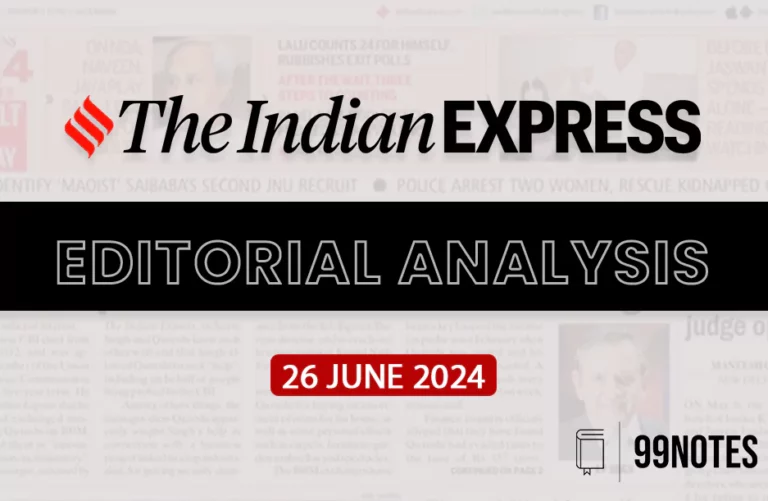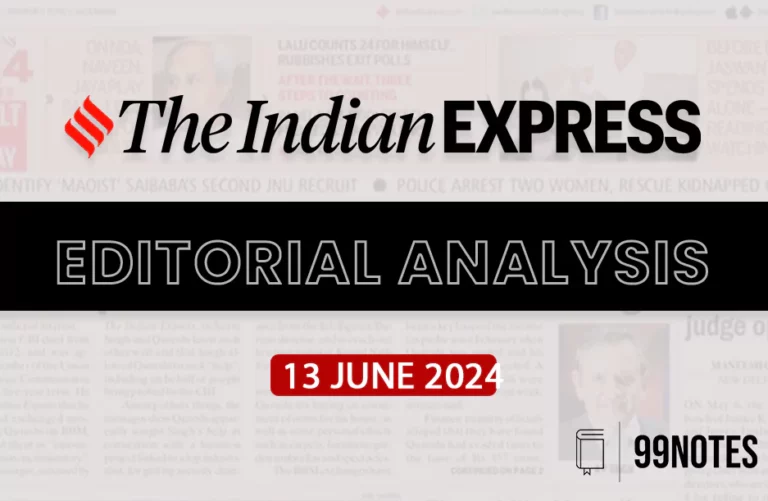9 Jan 2024 : Indian Express
Indian Express
9- January-2024
1. Mind the cereal gap
| Topic: GS3 – Agriculture- Issues of buffer stocks and Food Security This topic is not much relevant in the context of Prelims but more for Mains in the context of India’s cereal production and consumption, along with the associated policy dilemmas and implications. |
| Context: |
|
Declining Per Capita Consumption Trend:
- The amount of cereal consumed per person has been falling over time; this trend is not due to an increase in poverty but rather to urbanisation, higher levels of education, a more varied diet, and possibly less physical activity.
- It is difficult to determine current trends due to the 75th NSS Round’s suppression, but state-level data for Maharashtra indicates a persistent fall between 2011–12 and 2017–18.
Exploring the Gap:
- Traditionally, the Economic Survey has subtracted 12.5% for seed, feed, and waste (SFW) in order to determine “net production.”
- But in recent years, there has been an increasing disparity between net availability and household demand, which reached 36 million tonnes in 2020–21 and 33 million tonnes in 2021–22.
- Inadequate SFW allowance and doubts over higher grain consumption for human consumption, animal feed, or industrial applications are possible causes of this disparity.
Unraveling the Cereal Gap Mystery:
- The large disparity raises concerns regarding the real direction of cereal consumption.
- Does the public distribution system play a role in the rise in consumption?
- Are there any unanticipated uses, such increased animal feed or industrial applications?
- Understanding this cereal gap is made more difficult by the dearth of thorough data and the seeming ambiguity of statistical reporting.
Policy Implications:
- The cereal gap presents important policy issues in addition to a statistical puzzle.
- With grain production growing at a rate of about 3% annually, officials should think about diversifying away from wheat and rice.
- A comprehensive grasp of the demand scenario is needed in order to guarantee Indian farmers fair pricing.
- In order to prepare for India’s agricultural production in the future and possibly investigate opportunities such as cereal exports, it becomes necessary to address these questions.
- India’s agriculture policies require a holistic strategy, as highlighted by the current statistics disarray.
| PYQ: What are the salient features of the National Food Security Act, 2013? How has the Food Security Bill helped in eliminating hunger and malnutrition in India? (250 words/15m) (UPSC CSE (M) GS-3 2021) |
| Practice Question: Discuss the potential impact of the cereal gap on food security and suggest policy reforms to enhance the efficiency and inclusivity of the current agricultural ecosystem. (150 words/10 m) |
2. Diplomacy in the digital public square
| Topic: GS2– International Relations This topic is not much relevant in the context of Prelims but more for Mains in the context of India-Maldives relations. |
| Context: |
|
Background of India-Maldives Relations: Rising Tensions
- With allegations of Indian meddling in internal matters and worries about the Maldives’ increasing closeness to China, tensions between India and the Maldives have been rising.
- Discord was further exacerbated by President Mohamed Muizzu’s “India Out” stance and decision not to make the customary trip to New Delhi.Digital Outcry and Diplomatic Fallout:
- Maldivians rejected comparisons to Lakshadweep, which sparked inflammatory comments about Modi by Maldivian Deputy Minister Mariyam Shiuna.
- This marked the beginning of the digital escalation. Indians, especially celebrities, were outraged by this and demanded a boycott of the Maldives.
- While distancing itself from Shiuna’s remarks, the Maldivian government suspended her along with two of her colleagues.
Digital Diplomacy Dynamics: The Impact of social media
- This episode shows how susceptible diplomacy is to impromptu comments made on social media.
- The digital movement highlights the widening gap between the public’s perception and India’s official foreign policy.
- Public protest now affects international relations in real-time, disrupting the conventional closed-door method in the emerging field of social media-driven diplomacy.
India’s Social Media Landscape: Intersection of Politics and Global Opinions
- A same phenomena can be observed in India’s social media scene, where users are vociferous about their positions on international topics.
- Examples include hashtags that represent both grassroots beliefs and the impact of right-wing ideology affecting conversations, such as #IStandWithPutin during the Russian invasion of Ukraine.
Risks and Complexities: Diplomacy at the Crossroads
- One runs the danger of alienating partners and having to choose between forging strategic relationships and domestic appeasement when popular opinion controls diplomatic positions.
- Social media makes it clear how domestic politics and international relations connect in India, highlighting the growing impact of right-wing ideology in forming foreign policy narratives.
Contradictions in Diplomacy: Israel Disinformation Campaign
- The inconsistencies between India’s official position and social media narratives are brought to light by instances of right-wing and Hindu nationalist accounts in India endorsing Israel during its conflict with Palestine.
- The contradiction highlights how difficult it is to manage foreign policy in the digital era when official stances sometimes conflict with nationalist beliefs.
Conclusion:
- India is facing difficulties as it attempts to navigate the intricacies of diplomacy fueled by social media and the growing divide between official policy and popular opinion.
- Nuanced strategies are necessary to strike a balance between strategic alliances, home opinion, and global isolation, underscoring the importance of having a flexible and cohesive foreign policy plan.
| What is the “India Out” Campaign? |
|
| PYQ: Discuss the political developments in Maldives in the last two years. Should they be of any cause of concern to India? (200 words/10m) (UPSC CSE (M) GS-2 2013) |
| Practice Question: Evaluate the influence of social media in escalating tensions between India and the Maldives. (150 words/10 m) |
For Enquiry

13 Feb 2024 : Daily Current Affairs Quiz

13 Feb 2024 : Daily Answer Writing

13 Feb 2024 : Daily Current Affairs

13 February 2024 : The Hindu Editorial Notes PD

13 Feb 2024 : Indian Express Editorial Analysis

13 February 2024 : PIB Summary for UPSC

12 Feb 2024 : Daily Current Affairs Quiz

12 Feb 2024 : Daily Answer Writing

12 Feb 2024 : Daily Current Affairs

12 Feb 2024 : Indian Express Editorial Analysis
Daily Quiz 13 Feb 2024 : Daily Current Affairs Quiz 13 Feb 2024 : Daily Quiz…
mains answer writing 13 Feb 2024 : Daily Answer Writing Mains Answer Writing
13-February-2024
Q1) With the help of a map, show major ocean currents of the world….
Daily Current Affairs 13 Feb 2024 : Daily Current Affairs Daily Current Affairs
13-February-2024- Top News of the Day
1. Indian Navy Personnel Released from Custody…
Feb 2024 The Hindu 13 February 2024 : The Hindu Editorial Notes PD The Hindu Editorial
13-February-2024
1. A global alliance to bridge the gender equity gap
Topic:…
Indian Express 13 Feb 2024 : Indian Express Editorial Analysis Indian Express Editorial Analysis
13-February-2024
1. A science for us
Topic: GS2 – Governance…
feb 2024 PIB 13 February 2024 : PIB Summary for UPSC PIB Summary for UPSC
13-February -2024
1. Union Minister G Kishan Reddy inaugurate regional centre…
Daily Quiz 12 Feb 2024 : Daily Current Affairs Quiz 12 Feb 2024 : Daily Quiz…
mains answer writing 12 Feb 2024 : Daily Answer Writing Mains Answer Writing
12-February-2024
Q1) “Water scarcity threatens economic and social gains…
Daily Current Affairs 12 Feb 2024 : Daily Current Affairs Daily Current Affairs
12-February-2024- Top News of the Day
1. Great Indian Bustards give Nandyal a…
Indian Express 12 Feb 2024 : Indian Express Editorial Analysis Indian Express Editorial Analysis
12-February-2024
1. CLASSROOM VS COACHING
Topic: GS2 – Social…



